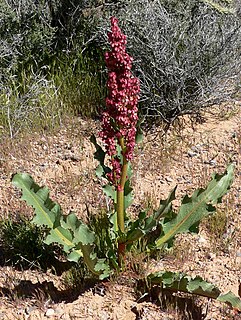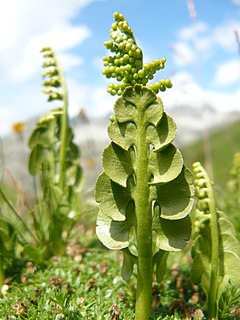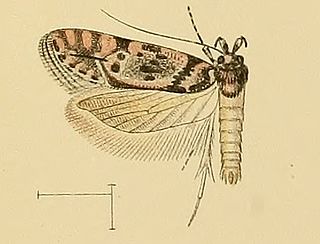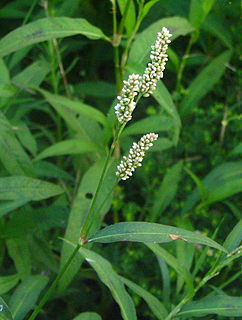
Common sorrel or garden sorrel, often simply called sorrel, is a perennial herb in the family Polygonaceae. Other names for sorrel include spinach dock and narrow-leaved dock. It is a common plant in grassland habitats and is cultivated as a garden herb or salad vegetable.

Lunaria is a genus of flowering plants in the family Brassicaceae, native to central and southern Europe. It includes 4 species, the annual or biennial L. annua, Lunaria elongata, the perennial L. rediviva and the rare Balkan species Lunaria telekiana

The docks and sorrels, genus Rumex L., are a genus of about 200 species of annual, biennial, and perennial herbs in the buckwheat family Polygonaceae.

Rumex crispus, the curly dock, curled dock or yellow dock, is a perennial flowering plant in the family Polygonaceae, native to Europe and Western Asia.

Lunaria annua, called honesty or annual honesty in English, is a species of flowering plant native to the Balkans and south west Asia, and naturalized throughout the temperate world.

Rumex obtusifolius, commonly known as bitter dock, broad-leaved dock, bluntleaf dock, dock leaf or butter dock, is a perennial weed in the family Polygonaceae. It is native to Europe but can now be found in the United States and many other countries around the world such as Australia and New Zealand.

A silique or siliqua is a type of fruit having two fused carpels with the length being more than three times the width. When the length is less than three times the width of the dried fruit it is referred to as a silicle. The outer walls of the ovary usually separate when ripe, then being named dehiscent, and leaving a persistent partition. Siliques are present in many members of the mustard family, Brassicaceae, but some species have silicles instead. Some species closely related to plants with true siliques have fruits with a similar structure that do not open when ripe; these are usually called indehiscent siliques.

In the flowering plants, an ovary is a part of the female reproductive organ of the flower or gynoecium. Specifically, it is the part of the pistil which holds the ovule(s) and is located above or below or at the point of connection with the base of the petals and sepals. The pistil may be made up of one carpel or of several fused carpels, and therefore the ovary can contain part of one carpel or parts of several fused carpels. Above the ovary is the style and the stigma, which is where the pollen lands and germinates to grow down through the style to the ovary, and, for each individual pollen grain, to fertilize one individual ovule. Some wind pollinated flowers have much reduced and modified ovaries.
1067 Lunaria, provisional designation 1926 RG, is a stony Itha asteroid from the outer regions of the asteroid belt, approximately 18 kilometers in diameter. It was discovered on 9 September 1926, by astronomer Karl Reinmuth at the Heidelberg-Königstuhl State Observatory in southwest Germany. The asteroid was named after the flowering plant Lunaria (honesty).

Rumex hymenosepalus, commonly known as canaigre, canaigre dock, ganagra, wild rhubarb, Arizona dock, and tanner's dock, is a perennial flowering plant which is native to the western United States and northern Mexico. It is a common food plant of the ruddy copper larvae.

Rumex longifolius, commonly known as the dooryard dock or northern dock, is a perennial species of plant in the genus Rumex.

Rumex maritimus, common names golden dock, bristle dock, or seashore dock, is an annual plant species of the genus Rumex.

Rumex patientia, known as patience dock, "garden patience", "herb patience", or "monk's rhubarb", is a herbaceous perennial plant species of the genus Rumex, belonging to the family Polygonaceae. In spring it is often consumed as a leaf vegetable in Southern Europe, especially in Bulgaria, Republic of Macedonia and Serbia. It is also used in Romania in spring broths or sarmale.

Canararctia rufescens is a moth of the family Erebidae. It is endemic to La Gomera and Tenerife.

Botrychium lunaria is a species of fern in the family Ophioglossaceae known by the common name moonwort or common moonwort. It is the most widely distributed moonwort, growing throughout the Northern Hemisphere across Eurasia and from Alaska to Greenland, as well as temperate parts of the Southern Hemisphere.

Calybites phasianipennella is a moth of the family Gracillariidae. It is known from all of Europe and most of Asia.

Rumex scutatus is a plant in the buckwheat family, used as a culinary herb. Its common names include French sorrel, buckler sorrel, shield-leaf sorrel, and sometimes the culinary name "green-sauce".
Eupithecia tenerifensis is a moth in the family Geometridae. It is endemic to the Canary Islands.

Teleiopsis lunariella is a moth of the family Gelechiidae. It is found on the Canary Islands.
Monochroa rebeli is a moth of the Gelechiidae family. It was described by M. Hering in 1927. It is found on the Canary Islands.





















